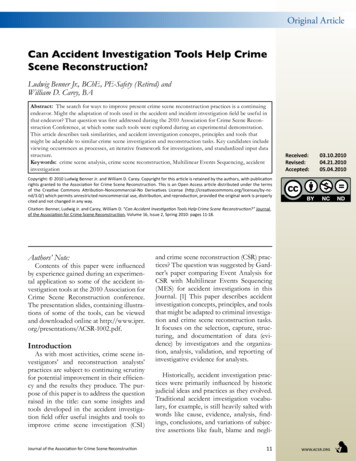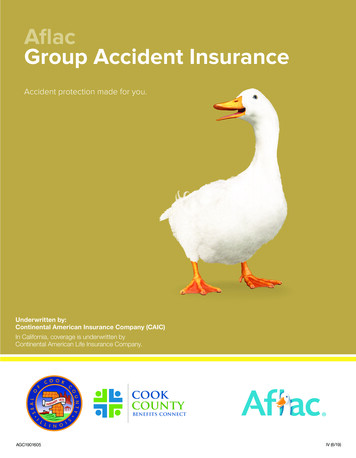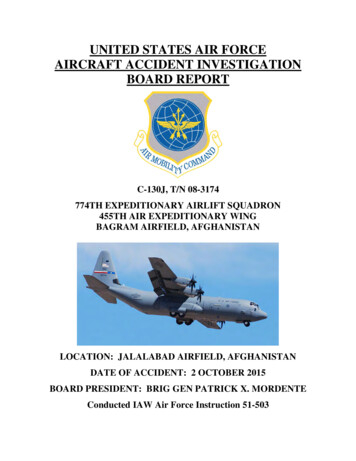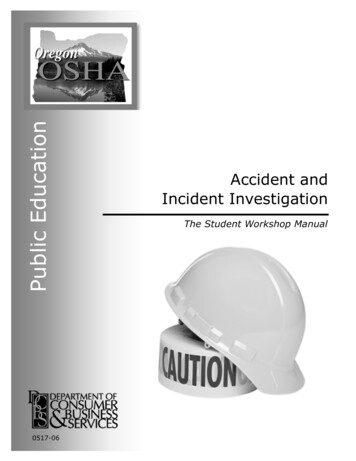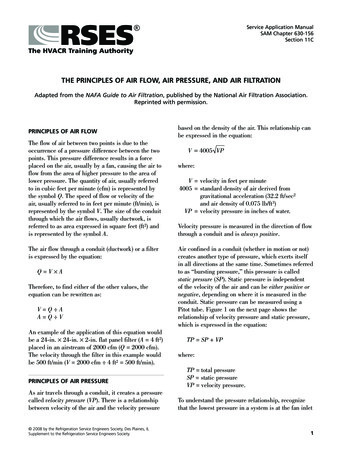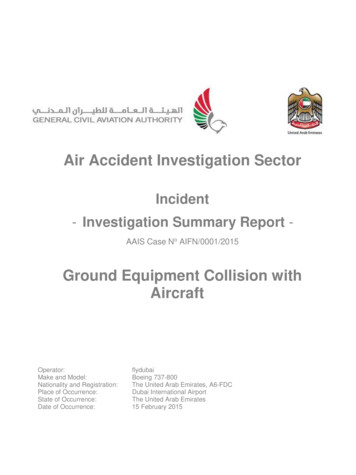
Transcription
Air Accident Investigation SectorIncident- Investigation Summary Report AAIS Case No AIFN/0001/2015Ground Equipment Collision withAircraftOperator:Make and Model:Nationality and Registration:Place of Occurrence:State of Occurrence:Date of Occurrence:flydubaiBoeing 737-800The United Arab Emirates, A6-FDCDubai International AirportThe United Arab Emirates15 February 2015
Investigation ObjectiveSince at the time of the occurrence, neither thecrew nor passengers had yet boarded the Aircraft,the occurrence was not classified under Annex 13to the Convention on International Civil Aviation, butthe Investigation was performed by the Air AccidentInvestigation Sector (AAIS) pursuant to the UAEFederal Act No. 20 of 1991, promulgating the CivilAviation Law, Chapter VII- Aircraft Accidents,Article 48. It is in compliance with the Civil AviationRegulations (CARs), Part VI Chapter 3, inconformity with Annex 13, and in adherence to theAir Accidents and Incidents Investigation Manual. (dnata)- the ground service providerat Dubai International Airport andpart of the Emirates Group. (flydubai)- the Operator of theAircraft.2.Unless otherwise mentioned, all times inthe Report are local time (UTC was localtime – (minus) 4h).3.Photos and figures used in this Report aretaken from different sources and areadjusted from the original for the solepurpose to improve the clarity of theReport. Modifications to images used inthis Report are limited to cropping,magnification, file compression, orenhancement of colour, brightness,contrast, or addition of text boxes, arrowsor lines.4.This Summary Report is structured usingthe relevant headings as depicted inAnnex 13 Final Report format.Investigation Process5.The occurrence involved a Boeing 737-800passenger Aircraft, registration A6-FDC, and wasnotified to the AAIS Duty Investigator (DI) by phonecall to the Hotline Number ( 971 50 641 4667).Airport Operator is an aerodromecertificate holder that operates under CARpart IX.6.Ground Handling Agents are all serviceproviders that produce service to theaircraft or its operations.The sole objective of this Investigation is toprevent aircraft accidents and incidents. It is not afunction of the AAIS to apportion blame ordetermine liability.This Summary Report is made public vestigationReport.aspxAfter the Initial/On-Site Investigation phase, theoccurrence was classified as an 'Incident'.The scope of this Investigation is limited to theevents leading up to the occurrence; no aken.Notes:1.Whenever the following words arementioned in this Report with first Capitalletter, they shall mean the following: (Aircraft)- the Aircraft involved inthis Incident (Investigation)- the investigationinto the circumstances of thisIncident (Incident)- this Incident referred toon the title page of this Report (Report)- this Incident SummaryReportIncident Investigation Summary Report AIFN/0001/2015, issued on 12 July 20161
Factual InformationHistory of the IncidentOn 15 February 2015, flydubai Boeing 737-800Aircraft, registration A6-FDC, was parked on StandQ-05 of Dubai International Airport (OMDB), andwas scheduled to operate flight number FZ4359 toBagram (OAIX), at 0528 local time (LT).After the usual morning briefing, the handlingagent (dnata) supervisor handed the tasksschedule to the senior ground operator. Theschedule included the names of the operators withtheir nominated tasks. The dnata senior groundoperator supervised three operators during theshift, and two of the operators were nominated tooperate two Mobile Conveyer Belts (MCBs) to loadthe Aircraft.Figure 1. The MCB in contact with the engine. The MCBwas parallel to the AircraftAt approximately 0515 LT, the senior groundoperator dropped off the two nominated MCBoperators at the parking bays where the two MCBswere located. After performing the requiredequipment checks using the MCB OperatingInstruction, each of the operators drove hisassigned MCB to stand Q-05 where the Aircraftwas parked.The MCBs were to be docked with the Aircraftat the forward and aft cargo doors. One of theoperators had planned to position his MCB to theaft cargo door, but while driving towards the door,and at about five meters from the right enginecowling, the operator noticed that his colleaguehad already positioned the other MCB at the samedoor.The operator realised that he now had to drivethe MCB towards the vacant forward cargo door.The operator stopped the MCB and removed hisfeet from the MCB brake pedal in order to turn lefttowards the forward cargo door. Suddenly, theMCB moved forward towards the Aircraft andcollided with the right engine causing damage tothe engine shroud, acoustic panel, and inlet cowl(figures 1 and 2).There were no injuries to persons as a resultof the collision.Damage to AircraftFigure 2. Final position of MCB inside engine inletdamagePersonnel InformationThe MCB OperatorThe MCB operator joined dnata in 2008. Theoperator possessed a general driving license ratedas 'light vehicle driver' in 2005. Since joining dnata,the operator received training as a 'tractoroperator' and 'pick-up driver'. After training, theoperator worked as a 'tractor operator' until 2010.Thereafter, the operator was promoted to'airside operator grade 3’ as per the dnataemployment scale levels. He then receivedtraining on passenger steps, hi-loader, transporterof cargo loading-unloading, and MCB operations.-The engine shroud sustained damage at the 6o’clock position.Meteorological Information-Acoustic panel tear at the 8 o’clock position.The weather report between 0500 and 0600LT showed wind speed of about 5 knots, from-One deep long scratch on the right engine inletcowl at the 8 o’clock position (figure 2).Incident Investigation Summary Report AIFN/0001/2015, issued on 12 July 20162
varying directions between 150 to 170 , CAVOK1,and QNH 1011 mbar.-Afternoon shift started at 1400, and endedat 2200; andThe Incident occurred during twilight and theweather was not a factor in this Incident.-Night shift started at 2200, and ended at0600 on the next morning.Organizational and ManagementInformationflydubaiThe starting and ending time of the duty rosterhad been changed from 1 February 2015 to:- Morning shift started at 0800, andended at 1600;flydubai holds an Air Operator Certificate(AOC) issued by the UAE General Civil AviationAuthority to operate aircraft type B737.flydubai submitted its Ground HandlingManual to dnata as instruction for ground handlingincluding a full schedule of detailed groundhandling procedures (GHM, REV. 51 May 2015,section 6).dnatadnata Airside ProceduresThe procedures on the day of the Incident didnot contain provisions for allocating tasks tooperators of the same type of equipment who wereservicing the same aircraft. The procedures did notallow for the provision of instructions to adviseeach of the MCB operators as to which cargocompartment his conveyer belt should bepositioned.dnata Airside operator’s rosteringAt the time of the Incident, the duty rostercovered eight hour days for six consecutive daysin different shifts (two mornings, two afternoonsand two nights), followed by two days off. Theworking hours for each shift were as follows:(All timings are local time)-Night shift started at 2400, and endedat 0800 on the next morning.The MCB operator was scheduled to work thenight shift. He reported for duty at 2400 LT. TheIncident occurred at 0630 LT in the last quarter ofthe duty period.Morning shift started at 0600, and endedat 1400.Dubai International Airport is certified underthe UAE CAR Part IX- Aerodromes, and DubaiAirports is the recognised airport operatorThe Airport is equipped with three terminals,and the Incident Aircraft was parked at Terminal 1.The stand numbers were marked on the tarmac inbold letters and were equipped with lights. Thelights were lit at the time of the Incident.Additional InformationThe operations and handling services arereferenced in the Service Level Agreement (SLA)between the air operator and the ground handlingagent. The airport had no direct contribution insuch agreements.The policy and procedures of the turnaroundservices are usually established by the air operatorin its Ground Operation Manual. Ground handlingagents have their own operations standard setforth in the International Air Transport Association(IATA) Ground Operations Manual (IGOM)2.Ground handling agents which ments are qualified for the IATA Safety21Afternoon shift started at 1600, andended at 2400; andDubai International Airportdnata provides ground handling servicesincluding supply of and maintenance of groundsupport equipment, and the technical handling ofthird party airlines. At the time of the Incident,dnata was contracted to flydubai for rampservices.--CAVOK: Ceiling and Visibility OKThe IGOM is a definitive source for the latest industryapproved standards harmonizing ground handlingprocesses and procedures for frontline personnel.Incident Investigation Summary Report AIFN/0001/2015, issued on 12 July 20163
Audit of Ground Operations (ISAGO)3 certificate,which is an essential requirement for entering intoservice level agreements with air operators.Dubai Airports operates a Safety ManagementSystem (SMS) that includes inspection and auditprograms of the ground handling agents.According to the program, the Operations DutyManager (ODMA) is assigned to carry out at leastfour turnaround inspections daily which is alsodocumented in the Aerodrome Manual. In addition,Dubai Airports conduct annual audits of the groundhandling agents. The inspections and audits arecarried out according to checklists contained in theAerodrome Manual. The audit findings aresummarized by the Dubai Airports SMS team anddiscussed on a monthly basis. In addition,accidents or incidents involving ground handlingagents are discussed by the SMS team anddecisions made regarding required actions.requires aerodrome operators to establish a‘maneuvering area/apron safety anizations, including ground handling agents.Among other tasks, the committee is assigned to:“ - evaluate operational safety issues;- receive reports and statistical informationon accidents and incidents, and proposesolutions; and- advice on Movement Area/apron safetyissues.”There is no regulatory reference thatempowers the Airport to carry out oversightfunctions on airport stakeholders, and there are nospecific Conditions of Use4 applicable to allstakeholders, similar to the one used as a term ofreference between Dubai Airports and airoperators.At the time of the Incident, the SMS5 used bydnata was that of the Emirates Group. Althoughdnata has a Hazard Identification, RiskAssessment and Determining Controls (HIRADC)procedure, which has been in place since 6February 2015, and has been reviewed by DubaiAirports during previous SMS audits; the HIRADCregister was not shared with Dubai Airports.However, dnata is in the process of improving theprocedure to work more collaboratively with DubaiAirports on risk assessments, particularly wherehazards are facility related.Appendix 20 of CAR Part IX- AcceptableMeans of Compliance and Guidance Material onAerodrome Management – Safety Programmes,34ISAGO program is an internationally recognized andaccepted system for assessing the operationalmanagement and control systems of an organization thatprovides ground handling services for airlines (the“Provider”). ISAGO is based on industry-proven qualityaudit principles and structured to ensure a standardizedaudit with consistent resultsConditions of Use is a document that contains terms ofreference that govern the relationship between airport andaircraft operators. In addition to the commercial aspectsthat form its majority, the condition of use contains Termsof Reference related to ramp operations5Emirates Group SMS has been developed tocommunicate the approach to Safety Managementthroughout the Group. The manual details the policies,procedures and requirements that are implemented tomeet the regulatory requirements of CAR Part X and otherapplicable CARsIncident Investigation Summary Report AIFN/0001/2015, issued on 12 July 20164
AnalysisPositioning of EquipmentThere are two locations in the Aircraft forloading/unloading: the forward and the aft cargodoors. The lack of a policy to assign each MCB toa specific door led to ambiguity for the groundhandling supervisor when assigning two airsideoperators for simultaneous MCB operations on thesame aircraft.distraction could not be prevented because therewas no predefined policy of assigning tasks.The Incident MCB operator brought the MCBfrom the parking bay E-43 to parking bay Q-05where the Aircraft was parked. The MCB operatordecided to drive the MCB to the aft cargo door.When he was moving towards the aft cargo door,he saw that the other MCB had already beenpositioned at that door. Accordingly, the MCBoperator realized that he must drive the MCBtowards the vacant forward right cargo door.The effect of duty time changes on thecircadian rhythm of the operators and thelikelihood involvement in fatigue, could not bedetermined by the Investigation. But theInvestigation believes that the lack of riskassessment of such change would keep latenthazards in place.The Investigation was unable to determine thereason for the collision between the MCB and theengine. Two likely scenarios were considered; theMCB driver was distracted and his attention wasdiverted from the task at hand resulting in a loss ofsituational awareness or, instead of depressingthe brake pedal he mistakenly depressed theaccelerator pedal causing the MCB to impact theengine (figure 1).dnata did not have explicit procedure forassigning specific positions and routes forsimultaneous similar tasks operated by differentoperators. Therefore, the decision of where toallocate the equipment was left to the equipmentoperator.Leaving decisions in normal operations forfield staff makes the operation vulnerable tosudden changes that may interrupt the humaninteraction with the environment and machine.Distraction, time pressure, tiredness will add moreto the likelihood of reacting inappropriately to thesudden change.If communications among operators in a workplace is insufficient, the information will not beupdated and communicated on due time betweenthe involved operators, accordingly it is likely thatat some stages, similar tasks made by differentpeople will cross each other’s at some pointcausing incidents.The perception of the MCB operator todistance, heading, and speed, was most likelydowngraded by distraction caused by unforeseenchange and time pressure. The MCB operatorSafety Management SystemThe change of the rostering time was made bythe dnata Resource Planning Department withoutinvolvement of dnata Safety Department.It was not determined whether the changes tothe roster had led to unexpected fatigue, resultingin the occurrence of the Incident. Changing theroster without carrying out a risk assessmentdeprived dnata of valuable safety information.dnata HIRADC procedure did not require riskassessment on the impact of the roster change.At the time of the Incident, dnata wasoperating under the remit of the Emirates GroupSMS.The links between dnata and Dubai Airports’SMS were:-Accident and incident reporting-ASAG/ Key stakeholder meeting-Accident investigations-Joint safety campaigns-Joint HAZOPsUAE Civil Aviation RequirementsThe current Civil Aviation Regulations statethat the aerodrome manual is a contract, and theairport should utilize it in order to enforce thehighest levels of safety.The airport can assume the management ofthe integrated SMS of safety. This function issupported by the fact that the airport is certificatedby acomprehensiveregulatory systempromulgated by the GCAA which is the officialregulatory body of the UAE.The direct relationship between the airport andthe GCAA gives the opportunity to the airport to bein direct touch with systematic safety and qualityfunctions and then to play an official role in theIncident Investigation Summary Report AIFN/0001/2015, issued on 12 July 20165
implementation of the SMS among all operators.Figure 3 illustrates a proposed SMS structure forthe airport and the other operators.GCAA Regulatory,certification, andOversight systemsEmpowerment of theairport to assumesafety atorAirport SMSand qualitysystemRampoperatorRampOperator(dnata)Figure 3. Network of SMS among airportand other operatorsConclusionsFindings(a) The Aircraft was certificated, equipped andmaintained in accordance with the existingrequirements of the Civil Aviation Regulationsof the United Arab Emirates.(b) The Aircraft was airworthy when it wasprepared for the flight before the Incident.(c) The MCB operator was licensed, trained andqualified for his responsibilities.(d) dnata Ground Handling Manual did notcontain an explicit procedure for exactequipment positioning whenever there wasmore than one similar piece of equipmentbeing operated at the same aircraft. Theparking positions were left to the individualground operators' choice.CausesThe Air Accident Investigation Sectordetermines that the probable causes of theIncident were:(a) Either the MCB driver was distracted orhis attention was diverted from the task athand when he noticed the other MCBdocked at the aft cargo door which causedhim to lose focus and concentration or,instead of depressing the brake pedal hemistakenly depressed the acceleratorpedal causing the MCB to unexpectedlymove forward and impact the engine.(b) There was no specific procedure in placeto precisely task each of the groundoperators to position the equipment at aspecific aircraft cargo door. The decisionas to where to position the equipment wasleft to the discretion of the individualoperators. The plan of the MCB operator,to position the MCB at the aft cargo doorwas not possible when he realized that theother MCB operator had alreadypositioned his MCB at that location.(c) The Risk Management System of thehandling agent did not detect thepossibilityofuncoordinatedtaskperformance in the positioning ofequipment to the aircraft.Safety RecommendationsSafety Actions TakenThe following response was submitted bydnata before the issuance this Summary Report:“dnata has carried out a riskassessmentofactivitiesandequipment operating within the ERAand implemented the following controlmeasures:1. Marshalling for allpositioning to an aircraftequipment2. Marshalling training of all staffworkingwithintheEquipmentRestraint Area (ERA)(e) dnata operated under the remit of the EmiratesGroup SMS.3. Revised work instruction showingcorrect approach of MCB or any GSEat the forward and aft hold of anaircraft.”(f) Risk Assessment was not performed for theairside operators’ rostered duty time change.The dnata action is acceptable to the AAIS.Incident Investigation Summary Report AIFN/0001/2015, issued on 12 July 20166
Summary Report Safety RecommendationsTheAirAccidentrecommends that:InvestigationSectorThe General Civil Aviation Authority (GCAA) ofthe United Arab EmiratesdnataIt is recommended that the GCAA:It is recommended that dnata in conjunction withDubai Airports:SR43/2016SR41/2016Carry out a Risk Assessment Study for anychange of procedure, equipment, or work rosterthat may affect the performance of airsideoperators.Dubai AirportsIt is recommended that Dubai Airports:SR42/2016Establish procedure to enhance oversight ofground handling agents to ensure that thehandling agents have well-established safety andquality management systems.Promulgate requirements for the integration ofSafety Management Systems operated by thevarious operators and service providers at theairport with the structure of the airport SafetyManagement System that is officially recognizedby CAR Part IX- Aerodromes, and CAR Part XSafety Management System.SR44/2016Promulgate requirements that empower airportoperators to assume safety and quality oversightof airside operators and service providers.This Report is issued by:Air Accident Investigation SectorGeneral Civil Aviation AuthorityThe United Arab EmiratesFax: 971 2 4491 270Email: aai@gcaa.gov.aeWebsite www.gcaa.gov.aeIncident Investigation Summary Report AIFN/0001/2015, issued on 12 July 20167
Incident Investigation Summary Report AIFN/0001/2015, issued on 12 July 2016 1 Investigation Objective Since at the time of the occurrence, neither the crew nor passengers had yet boarded the Aircraft, . (IATA) Ground Operations Manual (IGOM)2. Ground handling agents which satisfy International Air Transport Association
